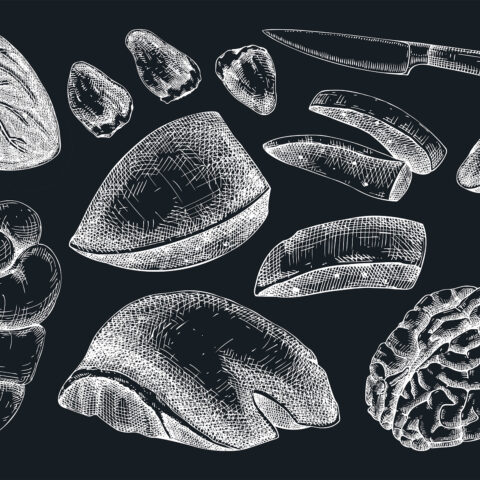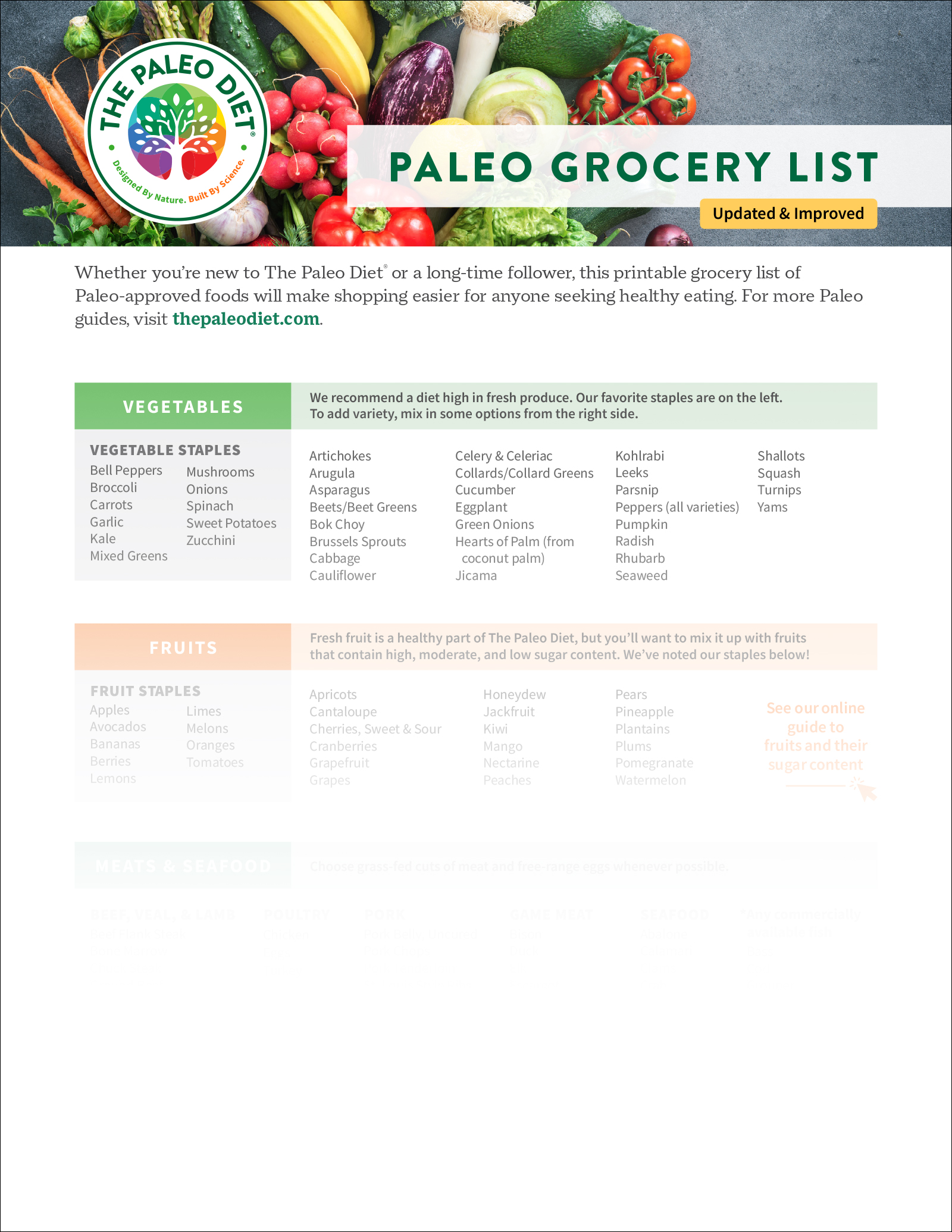The Benefits of High-Fiber Foods on Any Diet

Though The Paleo Diet® does not include certain high-fiber foods like whole grains and legumes, that doesn’t mean fiber intake has to take a backseat. Fiber is a vital part of a healthy lifestyle, and a well-balanced Paleo diet can still provide ample amounts through a variety of vegetables, fruits, nuts, seeds, and tubers.
What Is Fiber?
Fiber is a type of carbohydrate found in plant foods that the body cannot fully digest. While it isn’t a source of calories, fiber plays an essential role in digestion, gut health, and overall well-being. There are two main types of dietary fiber: soluble and insoluble. [1]
Soluble fiber dissolves in water and forms a gel-like substance. It’s known for helping to lower cholesterol, support balanced blood sugar levels, and support healthy gut bacteria. [2] Though oats and beans are widely known for their soluble fiber content, The Paleo Diet instead promotes other soluble fiber sources that are not pro-inflammatory and are higher in additional beneficial nutrients, such as apples (with skin), flaxseeds, cruciferous vegetables, root vegetables, and avocados.
Insoluble fiber doesn’t dissolve in water. Instead, it adds bulk to stool and promotes regular bowel movements. [3] Historically, nutrition experts have recommended whole grains for insoluble fiber, but you can also find it in many Paleo-friendly foods, including nuts, seeds, cruciferous vegetables, and fruits with skins. Most fiber-rich foods contain both types, in a ratio of one-third soluble fiber and two-thirds insoluble fiber. [4]
Why We Need Fiber
Fiber is key to maintaining a healthy gut microbiome, which has far-reaching effects throughout the body.
Healthy Gut
Certain fibers act as prebiotics, meaning they feed the beneficial bacteria in the gut. The bacteria ferment fiber and produce short-chain fatty acids (SCFAs) like butyrate, which reduce gut inflammation, strengthen the intestinal lining, and support immune function. [5]
Diets rich in fiber may also lower the risk of colorectal cancer. Fiber helps to remove waste from the digestive system, preventing buildup and irritation that may contribute to disease. The SCFAs also help keep inflammation at bay, reducing changes to the intestinal cells that could lead to cancer. [6]
Balanced Blood Sugar
Fiber-rich diets are linked to better insulin sensitivity, meaning the body uses insulin more effectively to regulate blood sugar and keep it stable. The fermentation of fiber by gut bacteria produces SCFAs, which have been shown to improve insulin secretion and glycated hemoglobin levels. [7]
Soluble fiber, when it forms a gel-like substance in the gut, also slows the digestion of carbohydrates and the release of glucose into the bloodstream. This action helps to prevent blood sugar spikes and crashes, leading to more stable energy levels. [8]
Healthy Weight
A side benefit of a fiber-rich diet may be a healthy weight. Because fiber helps to promote balanced blood sugar, a healthy gut, and feelings of satiety, it can make weight loss easier. [9]
A healthy gut microbiome, which fiber can help support, also plays a role in metabolic health and blood sugar regulation. Prebiotic soluble fiber helps to maintain a balanced gut microbiome, reducing inflammation that’s linked to insulin resistance and a tendency for weight gain.
Cardiovascular Health
A high-fiber diet also supports cardiovascular health by helping to balance cholesterol, regulate blood pressure, and stabilize blood sugar levels.
A 2022 systematic review and meta-analysis of over 8,000 people found that a high-fiber diet reduced systolic and diastolic blood pressure. It was also associated with an overall reduction in all-cause mortality compared to diets lower in fiber. [10]
Soluble fiber binds to cholesterol in the digestive tract, preventing absorption and promoting its removal. [11] In animal studies, soluble fiber specifically helps to reduce a blood protein called apolipoprotein B (ApoB), which is associated with plaque buildup in the blood vessels. [12] The SCFAs produced by beneficial gut bacteria help to lower systemic inflammation, a key factor in heart disease. [13]
Most Americans Don’t Get Enough Fiber
Unfortunately, most Americans don’t get enough fiber in their diets. The average American gets around 15 grams of fiber a day, while the recommended intake is between 25 and 38 grams a day, depending on age and gender. [1]
The main reason for the lack of fiber is an emphasis on grab-and-go ultra-processed foods and refined grains, and not enough fruits and vegetables. This convenience-focused processed diet is a key contributor to chronic conditions like autoimmune diseases, diabetes, and heart disease, and neurodegenerative diseases like Alzheimer’s disease.
High-Fiber Foods to Increase Your Intake
If you’re following The Paleo Diet and want to increase your fiber intake, you need to focus on fiber-rich, whole-food sources that align with Paleo principles, which means no grains or legumes. Some of the best Paleo-friendly fiber foods for increasing your intake include: [14]
- Non-Starchy Vegetables: Broccoli, cauliflower, Brussels sprouts, artichokes, asparagus, bell peppers, kale, and other leafy greens are rich in dietary fiber.
- Nuts and Seeds: Flaxseeds, almonds, walnuts, and sunflower seeds are high-fiber foods. They’re easy to add as snacks or on top of salads.
- Fruits: Berries (raspberries, blackberries, strawberries, and blueberries) are excellent sources of fiber, thanks to their seeds and skins. Avocados are another fiber-rich fruit that additionally provides healthy fats.
- Coconuts and coconut products: Coconut flour is an excellent baking ingredient for binding and absorbing moisture due to its high amount of insoluble fiber. Shredded coconut and fresh coconut meat are also great options.
- Tubers (in moderation): Sweet potatoes, turnips, carrots, and other root vegetables also provide fiber and essential nutrients.
The Paleo Diet Provides Fiber for Overall Wellness
Eating enough fiber on The Paleo Diet is entirely possible when you focus on whole, unprocessed plant foods like vegetables, fruits, nuts, and seeds. While other fiber sources like grains and legumes are not recommended on a Paleo diet, Paleo whole-food options can provide plenty of soluble and insoluble fiber to support digestion, blood sugar balance, and overall well-being. Incorporating high-fiber foods like leafy greens, cruciferous vegetables, berries, and coconut can help you maintain a healthy microbiome to promote a long and healthy life.
References
- Akbar A, Shreenath AP. High Fiber Diet [Internet]. PubMed. Treasure Island (FL): StatPearls Publishing; 2021. Available from: https://www.ncbi.nlm.nih.gov/books/NBK559033/
- Weickert MO, Pfeiffer AFH. Metabolic Effects of Dietary Fiber Consumption and Prevention of Diabetes. The Journal of Nutrition [Internet]. 2008 Mar 1;138(3):439–42. Available from: https://pubmed.ncbi.nlm.nih.gov/18287346/
- Soluble and insoluble fiber: MedlinePlus Medical Encyclopedia Image [Internet]. Medlineplus.gov. 2018. Available from: https://medlineplus.gov/ency/imagepages/19531.htm
- Wong JMW, Jenkins DJA. Carbohydrate Digestibility and Metabolic Effects. The Journal of Nutrition. 2007 Nov 1;137(11):2539S2546S. Available from: https://pubmed.ncbi.nlm.nih.gov/17951499/
- Ney LM, Maximilian Wipplinger, Grossmann M, Engert N, Wegner VD, Mosig AS. Short chain fatty acids: key regulators of the local and systemic immune response in inflammatory diseases and infections. Open Biology. 2023 Mar 1;13(3). Available from: https://pmc.ncbi.nlm.nih.gov/articles/PMC10049789/
- Kunzmann AT, Coleman HG, Huang WY, Kitahara CM, Cantwell MM, Berndt SI. Dietary fiber intake and risk of colorectal cancer and incident and recurrent adenoma in the Prostate, Lung, Colorectal, and Ovarian Cancer Screening Trial. The American Journal of Clinical Nutrition [Internet]. 2015 Aug 12;102(4):881–90. Available from: https://www.ncbi.nlm.nih.gov/pmc/articles/PMC4588743/
- Mao T, Huang F, Zhu X, Wei D, Chen L. Effects of dietary fiber on glycemic control and insulin sensitivity in patients with type 2 diabetes: A systematic review and meta-analysis. Journal of Functional Foods. 2021 Jul;82:104500. Available from: https://www.sciencedirect.com/science/article/pii/S1756464621001493
- CDC. Fiber: The Carb That Helps You Manage Diabetes [Internet]. Diabetes. CDC; 2024. Available from: https://www.cdc.gov/diabetes/healthy-eating/fiber-helps-diabetes.html
- Myhrstad MCW, Tunsjø H, Charnock C, Telle-Hansen VH. Dietary Fiber, Gut Microbiota, and Metabolic Regulation—Current Status in Human Randomized Trials. Nutrients [Internet]. 2020 Mar 23;12(3):859. Available from: https://www.ncbi.nlm.nih.gov/pmc/articles/PMC7146107/
- Reynolds AN, Akerman A, Kumar S, Diep Pham HT, Coffey S, Mann J. Dietary fibre in hypertension and cardiovascular disease management: systematic review and meta-analyses. BMC Medicine [Internet]. 2022 Apr 22;20(1). Available from: https://bmcmedicine.biomedcentral.com/articles/10.1186/s12916-022-02328-x
- Soliman GA. Dietary Fiber, Atherosclerosis, and Cardiovascular Disease. Nutrients [Internet]. 2019 May 23;11(5):1155. Available from: https://www.ncbi.nlm.nih.gov/pmc/articles/PMC6566984/
- Fernandez ML, Vergara-Jimenez M, Conde K, Behr T, Abdel-Fattah G. Regulation of apolipoprotein B-containing lipoproteins by dietary soluble fiber in guinea pigs. The American Journal of Clinical Nutrition [Internet]. 1997 Mar 1 [cited 2022 Nov 6];65(3):814–22. Available from: https://pubmed.ncbi.nlm.nih.gov/9062534/
- Hu T, Wu Q, Yao Q, Jiang K, Yu J, Tang Q. Short-chain fatty acid metabolism and multiple effects on cardiovascular diseases. Ageing Research Reviews. 2022 Nov;81:101706. Available from: https://pubmed.ncbi.nlm.nih.gov/35932976/
- Dietary Guidelines for Americans. Food sources of dietary fiber | Dietary guidelines for Americans [Internet]. Dietaryguidelines.gov. 2020. Available from: https://www.dietaryguidelines.gov/resources/2020-2025-dietary-guidelines-online-materials/food-sources-select-nutrients/food-sources-fiber
Betsy Schroeder
Betsy does research and writing for a few different websites in the natural health field after taking Masters level courses in Nutrition & Functional Medicine through the University of Western States.
More About The Author




